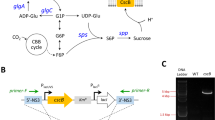Abstract
The unicellular cyanobacterium, Synechococcus elongatus PCC 7942 (Syn7942), synthesizes sucrose as the only compatible solute under salt stress. A series of engineered Syn7942 strains for sucrose production were constructed. The overexpression of the native sps (encoding a natively fused protein of sucrose phosphate synthase SPS and sucrose phosphate phosphatase SPP) in Syn7942 wild type caused a 93% improvement of sucrose productivity. The strain FL130 co-overexpressing sps and cscB (encoding a sucrose transporter) exhibited a 74% higher extracellular sucrose production than that overexpressing cscB only. Both results showed the significant improvement of sucrose productivity by the double functional protein SPS-SPP. Afterwards, FL130 was cultivated under a modified condition, and the cell-free culture medium containing 1.5 g L−1 sucrose was pre-treated with an acid hydrolysis technique. Cultivated with the neutralized hydrolysates as the starting media, two widely used microorganisms, Escherichia coli and Saccharomyces cerevisiae, showed a comparable growth with that in the control media supplemented with glucose. These results clearly demonstrated that the cell-free culture of sucrose-secreting cyanobacteria can be applied as starting media in microbial cultivation.
Similar content being viewed by others
References
Clerico, E. M., Ditty, J. L., and Golden, S. S., 2007. Specialized techniques for site-directed mutagenesis in cyanobacteria. Methods in Molecular Biology, 362: 155–171.
Deng, M. D., and Coleman, J. R., 1999. Ethanol synthesis by genetic engineering in cyanobacteria. Applied and Environmental Microbiology, 65 (2): 523–528.
Dhaliwal, S. S., Oberoi, H. S., Sandhu, S. K., Nanda, D., Kumar, D., and Uppal, S. K., 2011. Enhanced ethanol production from sugarcane juice by galactose adaptation of a newly isolated thermotolerant strain of Pichia kudriavzevii. Bioresource Technology, 102 (10): 5968–5975.
Du, W., Liang, F., Duan, Y., Tan, X., and Lu, X., 2013. Exploring the photosynthetic production capacity of sucrose by cyanobacteria. Metabolic Engineering, 19: 17–25.
Ducat, D. C., Avelar-Rivas, J. A., Way, J. C., and Silver, P. A., 2012. Rerouting carbon flux to enhance photosynthetic productivity. Applied and Environmental Microbiology, 78 (8): 2660–2668.
Jiang, W., Zhao, J., Wang, Z., and Yang, S. T., 2014. Stable high-titer n-butanol production from sucrose and sugarcane juice by Clostridium acetobutylicum JB200 in repeated batch fermentations. Bioresource Technology, 163: 172–179.
Li, N., Chang, W. C., Warui, D. M., Booker, S. J., Krebs, C., and Bollinger Jr, J. M., 2012. Evidence for only oxygenative cleavage of aldehydes to alk(a/e)nes and formate by cyanobacterial aldehyde decarbonylases. Biochemistry, 51 (40): 7908–7916.
Martinez-Noel, G. M., Cumino, A. C., Kolman Mde, L., and Salerno, G. L., 2013. First evidence of sucrose biosynthesis by single cyanobacterial bimodular proteins. FEBS Letters, 587 (11): 1669–1674.
Möllers, K. B., Cannella, D., Jorgensen, H., and Frigaard, N. U., 2014. Cyanobacterial biomass as carbohydrate and nutrient feedstock for bioethanol production by yeast fermentation. Biotechnology for Biofuels, 7: 64.
Morishige, Y., Tanda, M., Fujimori, K., Mino, Y., and Amano, F., 2014. Induction of viable but non-culturable (VBNC) state in Salmonella cultured in M9 minimal medium containing high glucose. Biological & Pharmaceutical Bulletin, 37 (10): 1617–1625.
Nayak, B. K., Roy, S., and Das, D., 2013. Biohydrogen production from algal biomass (Anabaena sp. PCC 7120) cultivated in airlift photobioreactor. International Journal of Hydrogen Energy, 39: 7553–7560.
Niederholtmeyer, H., Wolfstadter, B. T., Savage, D. F., Silver, P. A., and Way, J. C., 2010. Engineering cyanobacteria to synthesize and export hydrophilic products. Applied and Environmental Microbiology, 76 (11): 3462–3466.
Stanier, R. Y., Kunisawa, R., Mandel, M., and Cohen-Bazire, G., 1971. Purification and properties of unicellular blue-green algae (order Chroococcales). Bacteriology Review, 35 (2): 171–205.
Tan, X., Yao, L., Gao, Q., Wang, W., Qi, F., and Lu, X., 2011. Photosynthesis driven conversion of carbon dioxide to fatty alcohols and hydrocarbons in cyanobacteria. Metabolic Engineering, 13 (2): 169–176.
Varman, A. M., Xiao, Y., Pakrasi, H. B., and Tang, Y. J., 2013. Metabolic engineering of Synechocystis sp. strain PCC 6803 for isobutanol production. Applied and Environmental Microbiology, 79 (3): 908–914.
Author information
Authors and Affiliations
Corresponding author
Rights and permissions
About this article
Cite this article
Duan, Y., Luo, Q., Liang, F. et al. Sucrose secreted by the engineered cyanobacterium and its fermentability. J. Ocean Univ. China 15, 890–896 (2016). https://doi.org/10.1007/s11802-016-3007-8
Received:
Revised:
Accepted:
Published:
Issue Date:
DOI: https://doi.org/10.1007/s11802-016-3007-8




